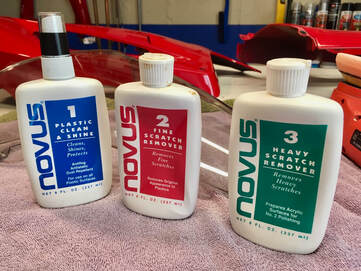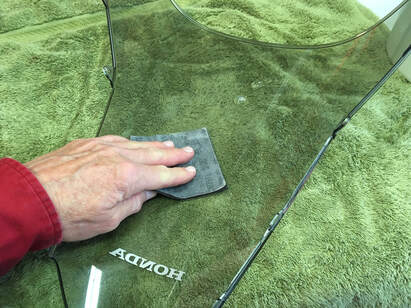
No surprises, and actually there's plenty of indicators that this bike has had some quality maintenance done throughout its life. Not surprising, as the previous owner added an extended warranty and service package when he purchased the 800 new.
I found a clean K&N air filter in place, a nice surprise, and an inspection of the various body pieces shows nary a crack nor broken fastener.

I've used Novus plastic polishing products for many years, but I've also found that going through a refinishing process just like I use on painted surfaces works well also. Either way, we can do a lot for our windscreens with some time and effort.


I refinish one side of the screen completely before beginning the other. This allows me to gauge my progress through the clear plastic.


This 17-year old screen isn't perfect, but it will perfectly compliment this refurbished Interceptor.
The safe way to clean acrylic is to flow clear, clean water over the screen while gently rubbing with the palm of your hand (no rings!) till the dirt and bugs dissolve. A diluted gentle soap can be used if necessary. Then dry with a known clean microfiber towel. If a drying towel is contaminated with any kind of grit it can't be used again till it's run through a washing machine (speaking of machine washing, never use fabric softener or dryer sheets when washing microfiber). The time to clean windscreens is right after riding when the bugs are still soft. If you find yourself with dried bugs, pre-soften them with a spray of hydrogen peroxide, allowing them to soften a few minutes before washing.
I pack two small microfiber cloths when on a ride — one for my face shield and one for the windscreen. I also pack a small, clean water-soaked cloth in a ziplock baggie for washing the shields, which goes into the wash after the ride. NEVER use spray cleaners containing ammonia (Windex), gas station water, scrub brushes, or any paper towel products to clean acrylics!! You're doing more harm than good. Okay, rant over.
 RSS Feed
RSS Feed